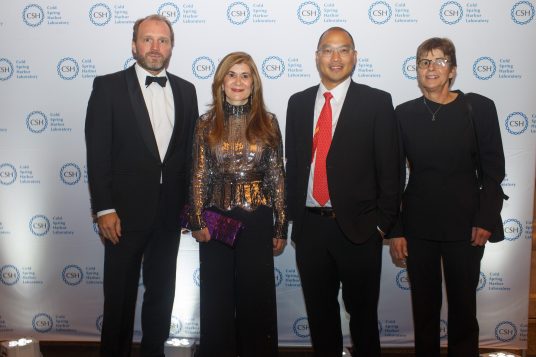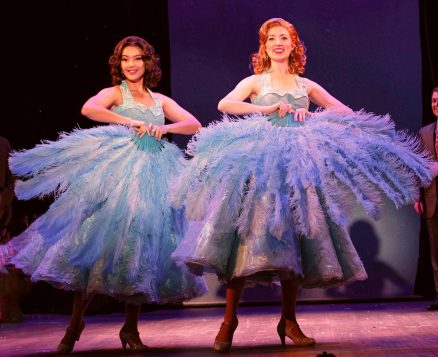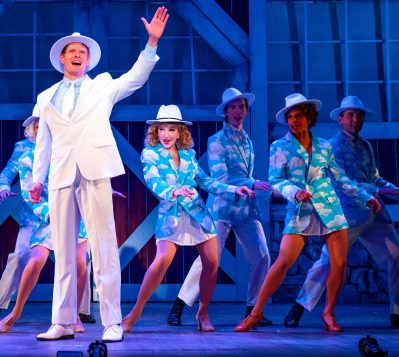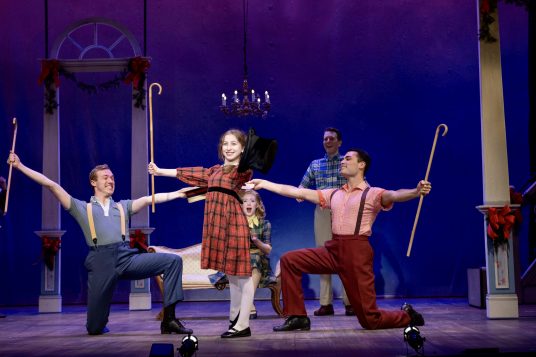CSHL celebrates science, Mr. October at Natural History Museum gala
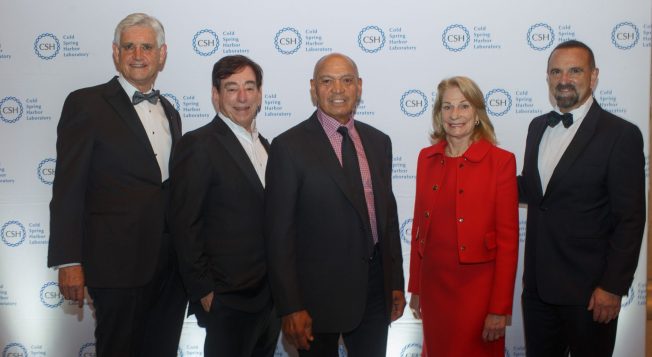
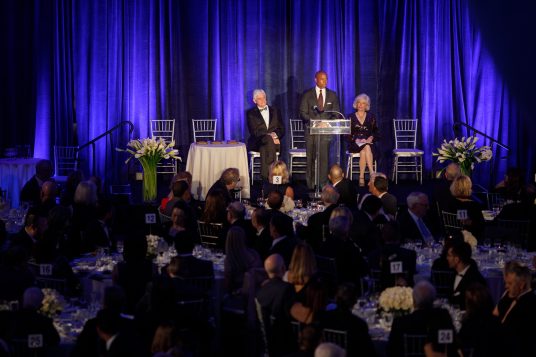
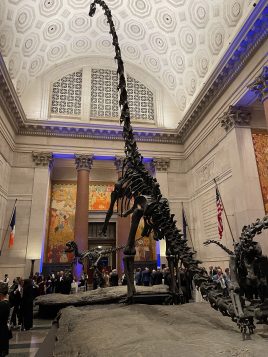
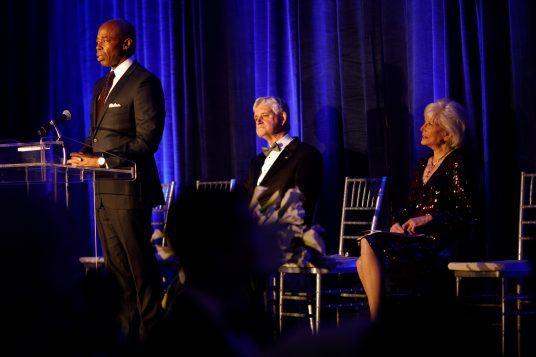
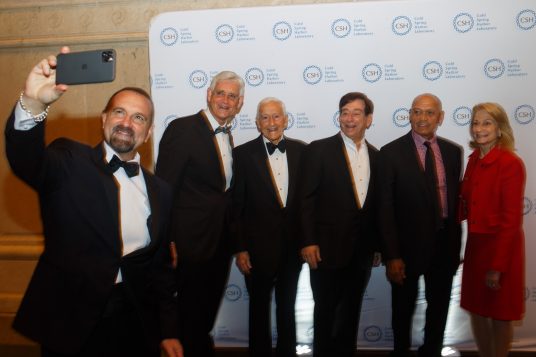
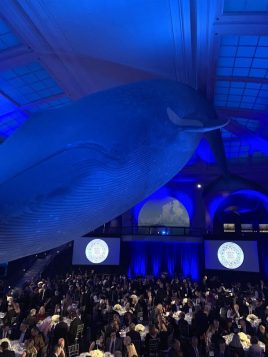
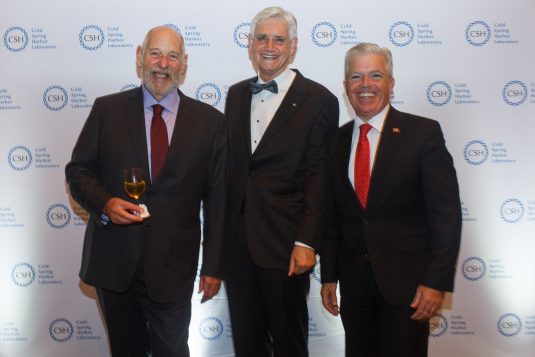
By Daniel Dunaief
This November, Cold Spring Harbor Laboratory celebrated baseball’s Mr. October.
The research facility that specializes in studying cancer, neuroscience, quantitative and plant biology hosted its 16th annual Double Helix Medals dinner at the Museum of Natural History on Nov. 17.
The evening, which was emceed by television journalist Lesley Stahl, honored Hall-of-Famer Reggie Jackson, as well as Leonard Schleifer and George Yancopoulos, the founders of Regeneron, the pharmaceutical company that has provided a life-saving antibody treatment for COVID-19.
The evening, which featured a dinner beneath the blue whale at the museum, raised a record $5 million for research.
“When we were standing in the hall of dinosaurs at the museum, it was fantastic,” said CSHL President and CEO Bruce Stillman. “It was one of the first events where people went out like the old days” prior to the pandemic.
Stillman said guests had to have received their COVID vaccinations to attend the celebration.
In addition to establishing a career as a clutch hitter in the playoffs, Reggie Jackson has dedicated considerable energy through his Mr. October Foundation to improve education around the country.
“His Mr. October foundation complements and parallels the DNA Learning Center programs, particularly now that we’ve opened a large DNA Learning Center in downtown Brooklyn that is serving underserved students in lab-based science,” said Stillman.
In his acceptance speech, Jackson said he found it “significant” that he received an honor for his educational efforts off the baseball field.
Yancopoulos, meanwhile, described his roots as the son of first generation immigrant parents from Greece. Yancopoulos highlighted the need for more funding in research and suggested that science helped pull the world through the pandemic. Yancopoulos said the National Institutes of Health should increase its budget 10-fold to meet the research and clinical needs of the population.
“Biotechnology offers the promise of really solving some of the most difficult problems that we face if we want our citizens to live not only longer, but healthier lives,” Schleifer said in a statement.
Mayor-elect Eric Adams, meanwhile, gave a speech about his vision for the future of the city which included, after some prompting from Stillman, increasing science in the education system.
The Double Helix gala, which started in 2006 when the lab honored the late boxer Muhammed Ali, raises money that goes into CSHL’s operating budget to support research and education.
This year, the donations included a generous gift from Astros owner Jim Crane, who introduced his friend Jackson.
Stillman helps direct the funds raised through the dinner to support scientists who are making what he termed “breakthrough discoveries.”
Many of the most significant discoveries come through philanthropic support, Stillman said, which makes it possible for researchers to design high-risk, high-reward experiments.
CSHL Chair of the Board of Trustees Dr. Marilyn Simons, a previous winner, attended the festive evening.
Senior leadership at the lab chooses the honorees. Stillman said CSHL already has two honorees for the event next year.
Previous honorees include actor Michael J. Fox, basketball legend Kareem Abdul-Jabbar, actor and science educator Alan Alda, and newscasters including Tom Brokaw and Katie Couric.
“It is a really spectacular list,” Stillman said. The winners, who receive a medal, have all contributed in some significant way to science or to science education.
The dinner provides an opportunity for supporters of the mission of CSHL, which has had eight Nobel Prize winners work at the lab during their careers, to invite others to hear about research at the lab.
“It was a very inspiring evening,” Stillman said.
Editorial: Supporting small businesses this holiday season
There are certain things Cyber Monday and the internet can’t do for us as we shop during this holiday season. While the sales may be great online, there are some downfalls that we’ll experience this year making shopping locally even more important.
The next several weeks are going to be hard for devoted holiday shoppers thanks to COVID-19 and the continuous supply chain concerns that are happening across the country.
Experts are anticipating that large retailers like Apple and Amazon will experience a hit with sales due to shipping issues and staffing challenges. And although this will be tough for those businesses, it will also be a stress for the consumers themselves.
Whereas shopping via online Black Friday and Cyber Monday deals in the past was an easy click with shipping coming days after, buyers might see a delay in receiving those products in the mail.
But this might be a good time for us to take a step back and really support our neighbors who own their own shops in our local villages and towns.
Instead of anticipating a package in the mail — which might not even get here on time — we should head into town and shop small this holiday. The goods will be there right in front of us and we can take them home that day — easy one-stop shopping that makes our lives easier, but also provides income to a family owned business.
Shopping small comes with its own benefits: we can see the products, touch them and measure them for size. We can find unique things that may not be available on a larger company website, making that gift a one-of-a-kind present the recipient will treasure.
And on top of that, it provides that shop owner with extra money to pay their own bills. Shopping small is a win-win for everyone.
After a tough two years post the initial outbreak of the pandemic, mom and pops have been hit hard with little ability to recover.
By shopping locally this year, it brings money back to the economy which then goes back to our own street repairs and our community.
We know that online shopping is usually easier, but with the current state of inventory and the surrounding issues, it might actually be better to walk over and visit a family owned shop.
Try it out this holiday season, and you certainly won’t be disappointed.
D. None of the Above: Mundane and magnificent moments during and after a magical moon
By Daniel Dunaief

Ah, the benefits of an older bladder.
Granted, that’s not generally the case. Usually, I get up in the middle of the night, realizing that the dream that involves the search for a bathroom is my brain’s way of telling me that I need to urinate in real life.
I shift my weight slightly toward the floor, hoping that the rocking motion of my body doesn’t move the bed so much that I wake my wife or the cat sleeping on her, who sometimes sees my movement as a starter’s gun to race toward the table in the laundry room to devour another can of the same food he eats every day.
I slide my feet off the bed and try not to step on our huge dog, who moves around often enough that he could easily be that furry thing under my feet. My toes can’t always tell whether that’s him or just the softer part of the inside-out sweatpants I’ve been wearing for a week. I also try to avoid the other cat, whose tail is like a spring waiting for me to step on so he can shriek loudly enough to wake my wife and terrify the other cat and the dog.
When I reach the bathroom, I try to urinate into the bowl but away from the water to avoid any splashing sound. I retrace my steps back to the bed, hoping the safe places to step on the way out from the bed are still safe on the return.
This past week, the bathroom routine gave me the opportunity to look at a rare event. I watched the extended lunar eclipse, which was the longest it’s been in 580 years. I crept out to the hallway to view it through a window, hoping I didn’t have to go out in the cold to catch a glimpse of Earth’s shadow. I was also concerned that the dog, even at 3 a.m., would fear that he was missing out on something and bark, negating my efforts to enjoy the eclipse in silence.
I was amazed at the shadow that slipped slowly across the moon. I took an unimpressive photo that captured the yin and yang of the light and shadow.
The next morning, I ran into some neighbors on my routine walk with my dog.
After saying how they’d stayed up all night to watch this rare event — they are retired and don’t have any time pressure most days — they started to recount their evening.
“I was tempted to dress in black and howl while I watched it,” the man said.
“Excuse me?” I asked.
“Well, you know, I figured as long as I was up, the neighbors on the other side who think it’s OK to play basketball at 11:30 p.m. should know I was awake and active.”
“Hmm,” I said.
“Yeah, and the other day, they had a party and threw beer bottles over the fence into our backyard. It took until late in the day for them to pick them up.”
“That’s terrible,” I said. “Sorry to hear that.”
As I walked back with my dog, who was eager for his post-walk breakfast, I realized we had never discussed the sights from the night before.
Sleep deprivation overshadowed a discussion of the observation of the Earth’s long shadow.
As for me, I was, for the first time, grateful for the momentary need to pee. The evening and the morning interaction that followed brought to the fore a collision of the mundane and the magnificent.
Between You and Me: Chronic migraine reversal with the LIFE diet, a study by a local internist gone viral
By Leah S. Dunaief

A local physician had a remarkable result. In clinical practice, he was treating a patient with severe migraines. The patient, 60 years old, had been experiencing migraines for 12 years. Recently they increased in frequency, and he was enduring six to eight debilitating headaches per month, each lasting more than 72 hours. This equates to 18-24 headache days each month.
For those of us who suffer migraines, we know this must have been horrible. A migraine is not just a bad headache. It is as if a drill were unremittingly penetrating one spot in the head, all the while accompanied by nausea, vomiting and an inability to tolerate light. The aftermath is to feel hung over and unsteady. Migraines steal hours and days from the lives of the afflicted.
The patient had tried various traditional medications, like zolmitriptan and topiramate to no avail. He also avoided possible migraine triggers like aged cheese, caffeine and red wine without success.
The internist, who specializes in lifestyle medicine, put him on a plant-based, high nutrient diet that he created of essentially low inflammatory foods every day. Hence he named it the LIFE diet, and its centerpiece is composed primarily of dark leafy greens, frozen blueberries, a banana and soy milk in a smoothie. These high fiber ingredients, when reinforced with flax seed meal, and a little pomegranate juice, can be made into a 32-ounce drink by a sturdy electric blender. The diet is further reinforced by eating more nutrient-dense veggies, like spinach, kale, arugula and romaine lettuce, for example, at subsequent meals in the day. These foods are thought to reduce chronic inflammation in the body.
The LIFE diet also limits dairy and red meat, whole grains, starchy vegetables and oils, according to reporter Sarah Jacoby, who interviewed the doctor for “Today” last Thursday, Nov. 18.
The results of the new regimen were dramatic. After two months, the patient was experiencing one headache per month. After three months, the headaches were gone. The patient suffered no further migraines. This result has lasted more than seven years so far.
At this point, the local physician, teaming up with his brother, who is a medical researcher, wrote up the study and sent it to the highly prestigious British Medical Journal or BMJ that publishes medical case studies deemed important. Delighted when it was accepted for publication, the doctor, who is a passionate believer in the healing power of dark green leafy vegetables, was further pleased when he learned that BMJ, considering the study valuable enough, had sent out a press release to publications all over the world with a summary.
The response was overwhelming, a testament to the need for a remedy to a universal malady. As of this writing, more than 40 news outlets across the globe, including UPI and WebMD, have picked up the story, from Europe to the Middle East to Asia and Australia, translating it into a dozen different languages.
“I think this (case report) is a tremendous start in the treatment of migraine headaches,” added the local physician. “This is kind of revolutionary to have the ability to say, ‘Not only does it work, but it works in the worst case scenarios. And it works in a short period of time.’” He has seen similar results in other of his patients.
Dr. Charles Flippen, professor of neurology at the David Geffen School of Medicine at UCLA, agreed, stating that the change the patient experienced was, “rather impressive,” especially how long the effect has lasted. He added, “Now a large sample is necessary to draw conclusions about the benefits of diet change on migraines or chronic migraines,” as quoted by Sarah Jacoby for “Today.”
Dr. Dawn Buse, clinical professor in the department of neurology at Albert Einstein College of Medicine in New York said, “There have been some recent studies suggesting that major dietary changes can reduce migraine symptoms,” according to “Today.”
“Even though we don’t know the exact mechanism for migraine, the concept of an inflammatory process as part of the underlying physiology of chronic pain has been around for decades,” explained Flippen. “So the idea that you have a diet that reduces the production of pro-inflammatory substances would fit nicely with our current understanding of migraine … It’s not purely magic that it worked.”
For the doctor, whose work has now circled the globe, the satisfaction is enormous. “I went into medicine to help people. It’s beyond gratifying that I may be helping people to take their lives back by reversing disease with the LIFE diet,” he concluded.
And the name of the local internist who authored the study that has gone viral: my son and our own columnist, David Dunaief, MD.
Visit the Vanderbilt Museum and Planetarium for Thanksgiving weekend
The Suffolk County Vanderbilt Museum and Reichert Planetarium, 180 Little Neck Road, Centerport will be open Thanksgiving weekend, Friday through Sunday, November 26 to 28.
Visitors can take a guided tour of the Vanderbilt Mansion, decorated for the holidays by Ethan Allen and local garden clubs. Tour times on Friday, Saturday and Sunday are 12:30, 1:00, 2:00, 3:00, and 3:30 pm.
The Planetarium will also be open on Friday (on a Saturday daytime schedule), and throughout the holiday weekend. The Planetarium playbill offers shows for all ages and has just premiered its newest show, Explore, for or ages 14 and up. Take an odyssey to the planet Mars, seen through the lens of human history and scientific development. This visually stunning fulldome film begins with a look at how scholars and scientists throughout the ages have used the sky as a clock and calendar to measure the passage of time. Their charts and star catalogs informed the modern science of astronomy.
Before or after a tour or a show, visitors can stop by the Under the Stars café in the Planetarium lobby for sandwiches and treats from the renowned Copenhagen Bakery in Northport.
For more information, call 631-854-5579 or visit www.vanderbiltmuseum.org.
Traveling on the edge of a pandemic – Part one
Taking a solo backpacking tour through Europe proves the scars of COVID-19 are deep

Taking a solo backpacking tour through Europe proves the scars of COVID-19 are deep
By Kyle Barr
France

There was a young man in Toulouse, France, one of only two people in a hostel dorm room, the other being me. We were two in a room meant to facilitate 15. A Parisian traveler, he had taken trains and buses down to Toulouse, named the Pink City (Ville Rose) for its famous blush-red brick. We had a good sight of the street and that colored stone out of the window we shared between our beds.
“I want to see more of my country while I can,” he told me during that cool, wet night in July. He also told me he still hadn’t gotten a vaccine for COVID-19. I had, but I was sleeping just 3 feet away from him.
This should be a normal interaction for travelers through Europe but, in a space like that, the conversation inevitably moves toward the pandemic. He tells me he did not know why he hesitated to get the vaccine. It could have been nerves. It could be the kind of anti-authoritarian impulses that us Americans know only too well. He, along with so many French citizens, have railed against the French President Emmanuel Macron for their mandated proof of a vaccine or negative COVID test for everything from cafés to concerts.
On July 14, Bastille Day, protests rolled out from France’s cities. I watched one in Marseille make its way from the old docks up to the local municipal building. The protesters were shouting “Liberté!” while holding signs reading, “Mon corps m’appartient!” meaning “My body belongs to me!”

But the young Parisian man said that, despite his anger, it could actually change his mind.
“Maybe this will finally make me get the vaccine,” he told me.
Reuters’ data show an estimated 73% of France’s population has been vaccinated. That compares to an approximate 59% in the U.S. I wonder if that young man I met in Toulouse ever got his shot, but we were traveling in opposite directions, and I don’t think I’ll ever know.
There’s only one time that something can be done for the first time. So doing a European backpacking trip is one thing — an enormous thing to do as a novice. Doing it during a once-in-a-century pandemic is another thing entirely.
This past summer I made a very sudden decision to take a two-month backpacking trip through several countries in western Europe, starting June 23 and ending Aug. 18. Beginning in France, I went south to Basque country in Spain, back into France before going into Switzerland, then Germany, the Netherlands, then to Denmark before a quick flight over to Iceland.
My trip began on the very edge of when we all thought the pandemic would subside, just after many European countries started opening their doors to overseas travelers. My trip coincidentally ended just after those same nations started to roll back those open-armed policies. France instituted a COVID passport system just weeks after I left, and it is still only really available to French citizens, meaning that it would be nearly impossible to do half of what I could do just a few months before. Other European countries have instituted new restrictions and lockdowns. It means there was one small three-month period, one golden time slate when the classic Euro tour was still possible. That’s gone now.
Currently, rules are in flux, and Americans may find that restrictions can change between the time they book a trip and their departure dates. Unvaccinated U.S. passengers especially need to keep on top of all the changing regulations.

I wonder now if things will ever return to that golden age of pandemic-era travel and, at the same time, whether we ever should go back. Because even during this perfect period when summer travel was (mostly) possible if one carried a vaccine card tucked inside a passport, adventuring alone in pandemic-scarred lands is not as it once was. It may never be the same again.
Germany
I stayed in a total of 17 hostels, one tiny hotel, two Airbnbs and two stays at kindly people’s homes. During my visit to Hamburg, Germany, I chatted up the hostel staff and heard, like most hostels along my route, they were doing barely 30 to 40% of what they had done in 2019. Backpacking alone relies on one’s ability to strike up conversations with strangers, to meet new people from all over and organize a day’s activities, but the pandemic has done more than hamper worldwide travel. It has also changed certain attitudes. Less people seem to be willing to sit down with strangers to have conversations while the pandemic lingers.
That’s not to say people are more obtuse or less friendly, but there is a sort of wariness hanging about all interactions. Most travelers I met spoke similarly about that general feeling hanging like a cloud above people’s heads. Part of it was the lack of people in hostels, but there also was a defining sense of separation.
Kyle Barr is a freelancer writer and the former editor of The Port Times Record, The Village Beacon Record and The Times of Middle Country.
Editorial: Proceed with caution
As the days get shorter and the sun sets sooner, car crashes are more common. According to the American Automobile Association, after the clocks are turned back to standard time in the fall, more incidents happen between 5 p.m. and 7 p.m.
AAA recently reported that in 2020 there were 33,956 animal-related crashes in the state. Suffolk County, with 1,310 animal-related incidents, was the second highest in the state, tying with Monroe and behind Orange County. After the sun sets, residents are aware that animals can dart across the street, especially deer. Their sudden appearance on roadways in the fall is a regular occurrence as it’s rutting season for the creatures. It’s the time that they mate, and they have matters on their mind other than safety.
While the last thing any driver wants to do is hit an animal, there are other dangers to look out for after dark. Pedestrians can still be walking in the evening hours. Many people wear dark colors and are hard to spot. The problem is compounded when they aren’t carrying flashlights that would draw attention to them.
While pedestrians can take care to wear the appropriate clothing and take a flashlight or wear some type of reflective material on jackets or shirts, experts advise drivers to pay extra attention, especially on streets that are lit dimly or not at all.
In areas where deer signs are posted or while traveling in busy areas where people may be walking, it’s best to drive slowly, of course, and keep more distance than usual between your car and the one in front of you. The same advice can come in handy when leaves are wet and can cause dangerous road conditions that make it difficult to stop. If a driver finds a deer or a pedestrian close by, or tires slipping on leaves, the best thing is not to swerve suddenly and to brake slowly.
One last note, drivers need to make sure they stay centered in the lane. Many tend to gravitate more to the side when headlights go on; however, this can place vehicles even closer to pedestrians and animals. To make sure your car is centered in the lane, try to draw an imaginary line that goes from the asphalt to the sky. Look at the level of the horizon to stay on course if you feel you are gravitating to one side.
Driving at night can be a little tricky, but with extra care we can keep ourselves and our neighbors safe.
Businessman turned Huntington councilman talks about campaign, plans for new year
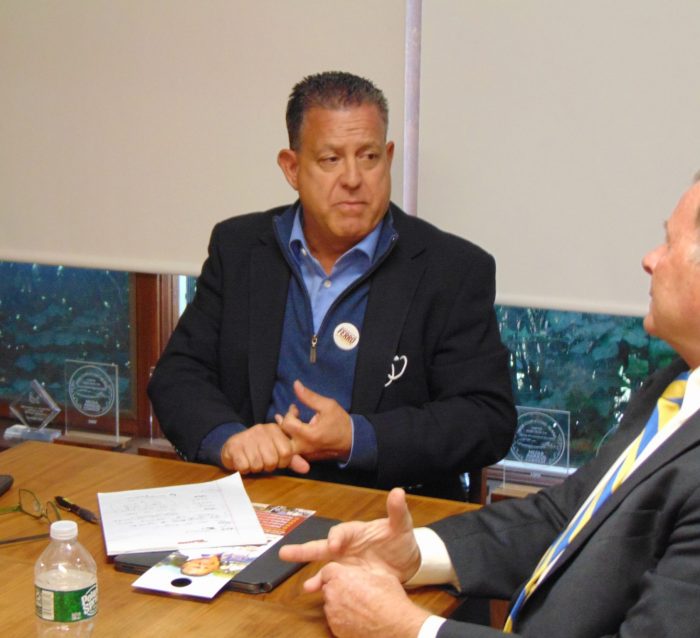
A CEO of a company known for remodeling homes is ready to make some improvements in the Town of Huntington.
“I focused on my accomplishments. I focused on my track record and focused on what I wanted to do rather than pulling people down.”
— Sal Ferro
This campaign season Sal Ferro, CEO of Alure Home Improvements, ran for office for the first time on the Republican and Conservative lines. Two seats were up on the Huntington Town Board when current councilmen Ed Smyth (R) and Mark Cuthbertson (D) decided to run for other offices, town supervisor and county legislator, respectively. Smyth was successful, Cuthbertson was not.
Ferro said he thought about running for office before this year.
“I thought about it in the past, and I always guessed the timing wasn’t right,” he said. “And, I think everything fell into place this time, that this was my time to do so.”
The businessman ran on the same lines along with running mate David Bennardo. Ferro said the two want the same things for the town. Bennardo also happens to be his two older children’s former principal.
On election night, Ferro gathered with other area Republicans at the American Legion Huntington Post 360 in Halesite to hear the voting results. He said after all the hard work of campaigning it was a satisfying night.
“It was especially gratifying for me, because I ran my race and didn’t do some traditional things that have been done in the past in campaigning,” the councilman-elect said. “I ran a very clean race. I focused on my accomplishments. I focused on my track record and focused on what I wanted to do rather than pulling people down.”
Ferro said he and Bennardo were proud that the race was a civil one. During a debate at the TBR News Media offices, Ferro and Bennardo along with their opponents, Democrats Jennifer Hebert and Joseph Schramm, demonstrated that civility. Ferro said the first call to congratulate him was from Schramm and later Hebert also called him.
“That just kind of shows you the tone of the race, which was ‘we’re all going to work hard, and we’re all going to do the best we can to win the race, because we all feel that we’re the best candidate, but we’re going to do so on our own accomplishments,’” he said.
Ferro said when he takes office in January he would like to start working on making things more efficient in the town’s building department.
“That’s something that I made a campaign promise, that I would work on the building department,” he said. “I know that’s something that’s not going to happen overnight, but I’d like to bring some ideas to the building department, and I’d like to bring some efficiency to the department.”
“It’s one of those things where you have to balance, put in time in both jobs, and it requires a lot of work. It’s something I knew going in.”
— Sal Ferro
As for the particulars, Ferro said he’ll know that once he gets into office and meets the people involved in the department. Besides drawing from his personal business experience, the councilman-elect said he will look at other towns that have had success.
“One thing I said was I like to use some best practices from other towns,” he added. “We don’t have to completely reinvent the wheel. There are things that are working elsewhere, that have happened elsewhere and didn’t take a long time to turn some other towns around quickly.”
The businessman, who also heads up the nonprofit Ferro Foundation which helps Long Islanders in need, plans on continuing as CEO of Allure, he said, and will be able to balance his work responsibilities due to his company’s “excellent team.” He added that he has never been one to sit on the sidelines.
“It’s one of those things where you have to balance, put in time in both jobs, and it requires a lot of work,” he said. “It’s something I knew going in.”
Theater Review: Northport’s Engeman Theater rings in the holidays with ‘White Christmas’
By Barbara Anne Kirshner
Phenomenal music, dance, comedy with romance sprinkled on top all wrapped up in a giant red velvet bow, that’s White Christmas, Engeman Theater’s gift to ring in this joyous season.
Last year, the holidays were dismal with theatres shut across our great nation due to COVID, but not even a sweeping pandemic could extinguish its spirit for long. Theater fought back, reigniting marques with brilliant neon lights announcing that the show would most certainly go on.
The Engeman proudly swung open its grand glass doors welcoming all who enter to enjoy the magic of live theatre once more and to celebrate the holidays it is treating audiences to an irresistible White Christmas. With music and lyrics by Irving Berlin and book by David Ives and Paul Blake, this musical is based on the much loved 1954 movie starring Bing Crosby, Danny Kaye, Rosemary Clooney and Vera Ellen. The first stage adaptation did not happen until 2004 when it premiered in San Francisco before playing a limited engagement on Broadway from Nov. 14, 2008, until Jan. 4, 2009.
The story revolves around two former WWII army buddies Bob Wallace and Phil Davis who, after the war, become successful entertainers, then big time producers. They get a letter presumably from an army buddy asking them to check out his sisters’ act at a local club. Sparks fly when they meet these sisters who are leaving that night for a Vermont Inn to fulfill a booking engagement. In pursuit of romance, Bob and Phil follow the ladies and discover that their former general who now owns this inn has fallen on hard times. The plot proceeds with mad cap comedy and extraordinary musical numbers.
With producing artistic director, Richard Dolce and managing director Kevin J. O’Neill at the helm, the Engeman is dedicated to creating Broadway caliber experiences for their audiences and White Christmas is professionalism at its very best.
This multi-talented ensemble is captivating. From the rollicking open numbers of Happy Holidays and White Christmas, Aaron Young as Bob Wallace and Daniel Plimpton as Phil Davis grasp us and never let go. Young’s voice richly floats through his every song while his stage presence is beguiling. Davis is a true song and dance man. The I Love a Piano duet featuring Darien Crago as Judy Hayes, is a tour de force tap number. Crago’s skill and energy mesmerizes in all her dance routines, making them appear effortless. Meadow Nguy as Betty Haynes soaring soprano sends chills especially in Love, You Didn’t Do Right by Me.
Rounding out this ensemble is an impressive supporting cast. Keith Lee Grant is riveting as the stern General Henry Waverly shouting out commands until he reaches a moment of reflection that allows the caring man within to materialize. Suzanne Mason as Martha Watson sporting red curls reminiscent of Lucille Ball and impeccable comedic timing takes center stage belting out Let Me Sing and I’m Happy and nearly stops the show. The general’s granddaughter, Susan Waverly, played by AnnaBelle Deaner, mimics Martha with a rousing reprise of the same song.
Director Matt Kunkel has created sheer perfection taking us on a memorable musical journey of sight and sound. Music Director Camille Johnson maintains energetic fluidity from start to finish with a band that is beautifully synchronized to the performers in every number.
Choreography is central to this show and Drew Humphrey’s lively routines from the tap numbers to a chorus line done with the precision of the Rockettes is outstanding. Sound design is essential in a musical and Laura Shubert has the levels just right.
This is a period piece musical therefore costumes must allow for ease of movement while reflecting the 1950’s era and Dustin Cross has created breathtaking silhouettes most notably the dreamy coats decorated with clouds in Blue Skies, the dazzling black and white ensembles in I Love a Piano with Judy’s belt that unwinds into piano keys and all those stunning red confections in the White Christmas and I’ve Got My Love to Keep Me Warm finale. Hair design is another essential element in a period piece and Conor Donnelly’s 1950’s hairstyles look authentic.
Kyle Dixon’s scenic design sets the tone and is functional as it morphs easily from one scene into the next giving the continuous feel of the magical holiday season by emphasizing reds, greens and whites. Dixon’s giant frames of white bark against green matting outlines the set and emphasizes a rural feel for the Vermont Inn. Aaron Bowersox’s lighting design adds brilliance to the big numbers and subtle touches for gentler moments.
White Christmas is a must-see festive treat for the entire family so ring in the holidays with this spectacular musical now through January 2, 2022. And be sure to return for the rest of their 2021-2022 season of exciting shows.
The John W. Engeman Theater is located at 250 Main Street in Northport. Tickets to the show range from $75 to $80 with free valet parking. To order, call 631-261-2900 or visit www.engemantheater.com.



